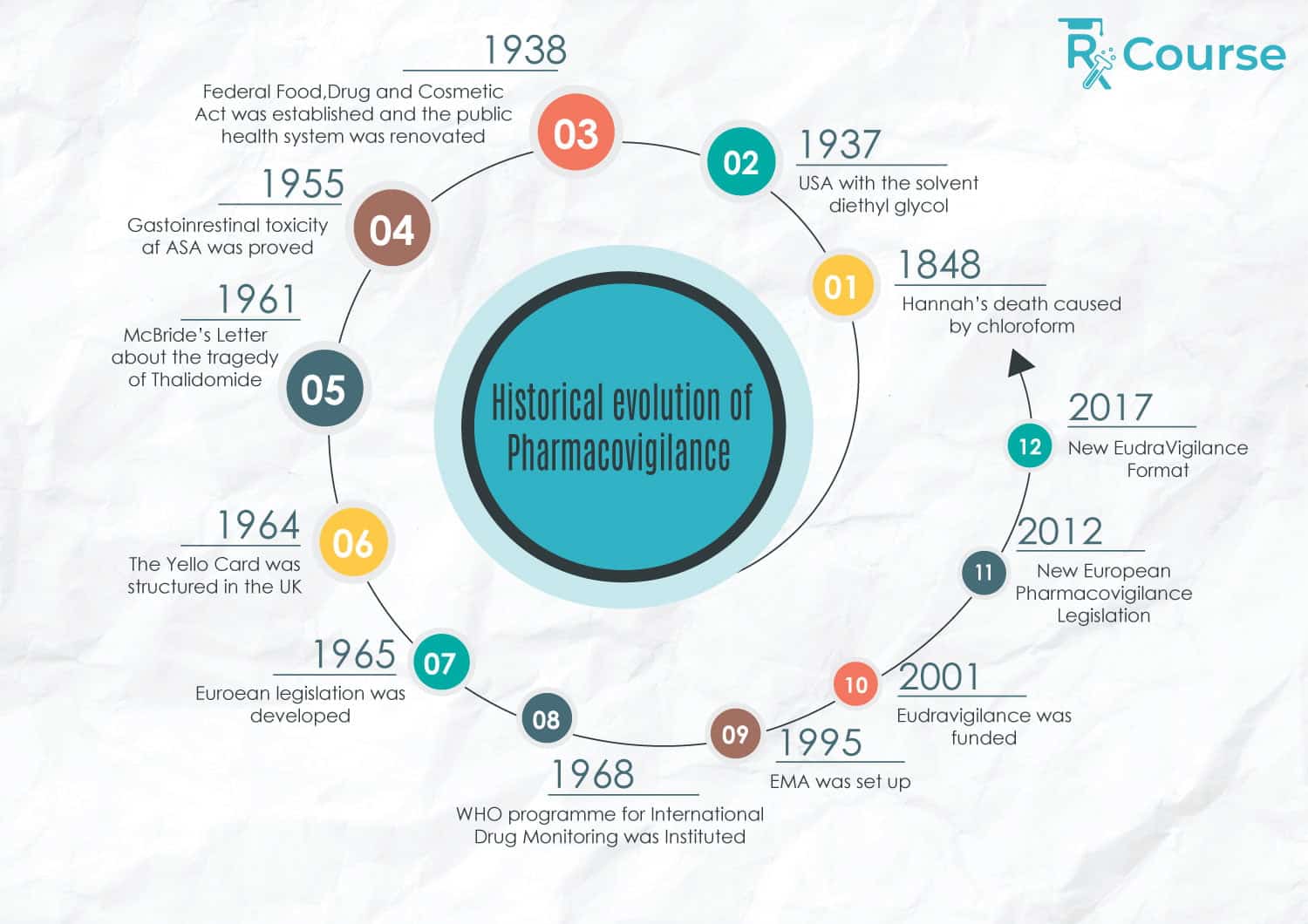History of pharmacovigilance: More than 60 years ago, about 10,000 children were born with devastating malformations in various countries worldwide. The clinicians and researchers were confused and wondered about the cause of this disaster. In 1961, two clinicians, Lenz and McBride, confirmed that thalidomide was the leading cause of this crisis.
Taking thalidomide during pregnancy to treat morning sickness was very common during this period. Clinicians were confident that thalidomide was safe during pregnancy. But unfortunately, it caused abortion to a large number of women besides fetal disabilities to born babies. And in the period from 1961 to 1962, thalidomide was withdrawn from most countries in the world. [1]
In response to this crisis, the UK released the Yellow Card Scheme in 1964 to facilitate drug toxicities’ reporting process. [2] And in 1965, the European legislation was established to regulate the operation[3] of medicinal products.
Then, the WHO founded the International Drug Monitoring Program in 1968 to detect adverse drug reactions worldwide. [4] In 1978, the scientific and technical responsibility of the WHO Program was transferred to Sweden. And it was the start of the first WHO collaborating center, the Uppsala Monitoring Centre in Sweden. [5]
In the mid-70s, a group of French pharmacologists and toxicologists suggested the term of Pharmacovigilance to assess the side effects’ risks of any drug treatment, and this was the very beginning of the pharmacovigilance journey. [4] The number of participating countries in this program gradually increased until it reached 134 countries by the end of 2010. [6]
But what about the decades before the thalidomide disaster? Do you think that people were not suffering from any adverse drug events? Or it is just the absence of communication and documentation.
Hannah’s Death in 1848 by Chloroform
About 169 years ago, a young girl was suffering from an infected toenail, which required surgical removal. And after receiving chloroform anesthesia, she died. The clinicians were in fog; they couldn’t know why Hannah died! Maybe she had severe arrhythmia or pulmonary aspiration.
But Hannah was not the only case who died after receiving chloroform anesthesia; other cases faced the same destiny. So, The Lancet asked the English doctors to report deaths after anesthesia, and in 1893, they published the results of these reports. [7]
Read also: The Impact and Importance of Pharmacovigilance
107 Americans Died in 1937 by Sulfanilamide Elixir
Actually, sulfanilamide elixir wasn’t the real cause behind those patients’ death, but its solvent (diethyl glycol) was the core reason for their death.
In this period, the pharmaceutical companies were not aware of diethyl glycol’s toxicity, which caused this catastrophe.
Concerning this event, the Federal Food, Drug, and Cosmetic were founded to guarantee drug safety before its approval and market release. [7]
Melena and acetylsalicylic acid (ASA)
In a published study, in 1938, Dr. Douthewaite assumed a causal relationship between the administration of acetylsalicylic acid and melena; however, the study findings couldn’t confirm his hypothesis. [8]
But soon after, in 1955, it was proved that acetylsalicylic acid causes gastrointestinal toxicities. [7]
Read also: Different Pharmacovigilance Jobs and Salaries in the US and Canada
From 1992 to 2017: Actions to Strengthen the Role of Pharmacovigilance
The following steps played a significant role in enhancing and supporting the role of pharmacovigilance all over the world:
- In 1992, the establishment of the European Society of Pharmacovigilance (ESOP) was an appreciable step to control the use of medications and its safety, which changed later to be the International Society of Pharmacovigilance (IsoP). [7]
- In 1995, the European Medicines Agency (EMA) was established. By monitoring and evaluating medicines in the European Union (EU) and the European Economic Area (EEA), the EMA played a crucial role in promoting and protecting human and animal health. Besides, it supports pharmacovigilance in the EU. And through its unique system, it prevents, detects, and assesses the adverse drug events. [9] Its system includes:
- The VigiBase (The WHO Database of Individual Case Safety Reports; the world’s largest database).
- The FAERS (The FDA Adverse Event Reporting System Database).
- The Canada Vigilance (The Health Canada Database).
- In 2001, Eudravigilance, the official European database, started its role in analyzing and managing the suspected adverse drug[9] events; it included the drugs under investigation, and that have been authorized for the market. [7]
- In 2012, some modifications were established in the European Pharmacovigilance, and this was the start of the New European Pharmacovigilance. A new definition for the Adverse Drug Reactions (ADR) is included in the New European Pharmacovigilance: “A response to a medicinal product which is noxious and unintended.” Because the new definition of ADR is broad, medication errors, drug misuse, and drug abuse were also included under the umbrella of this definition. In 2017, the new Eudravigilance was founded. [7]
- On December 16th, 2019, The Conservative Government of Canada added Vanessa’s Law, which not only includes the prescription and OTC medications, but also covers vaccines, medical devices, and gene therapies.[10]
To sum up, the concept of pharmacovigilance was present from the time of Hannah’s death. Maybe the term did not exist in this era; however, the clinicians, researchers, and scientific journals’ actions ensured the presence of pharmacovigilance concepts at that time.
As soon as you’re eager to learn more about pharmacovigilance and to gain new skills, join our pharmacovigilance course with Dr. Omar Aimer on RxCourse: https://www.innovigilance.com/
Written By: Sara Ahmed Zaki
References
- https://www.ncbi.nlm.nih.gov/pmc/articles/PMC4737249/
- https://www.ema.europa.eu/en/documents/presentation/presentation-adverse-drug-reaction-reporting-united-kingdom-view-mick-foy_en.pdf
- https://www.echamp.eu/eu-legislation-and-regulation-documents/directive_65-65-eec__-__consolidated_version.pdf
- https://www.ncbi.nlm.nih.gov/pmc/articles/PMC4576445/
- https://www.who.int/medicines/areas/quality_safety/safety_efficacy/collab-centre-uppsala/en/
- https://www.who.int/medicines/areas/quality_safety/safety_efficacy/pharmvigi/en/
- https://link.springer.com/article/10.1007/s11096-018-0657-1
- https://www.ncbi.nlm.nih.gov/pmc/articles/PMC2086550/?page=1
- https://www.openaccessjournals.com/articles/pharmacovigilance-international-classification-of-diseases-and-adverse-reaction-reporting-tools-used-in-united-states-of.pdf
- https://www.safekid.org/en/magazine-issue/issue-22/item/187-vanessa-s-law
